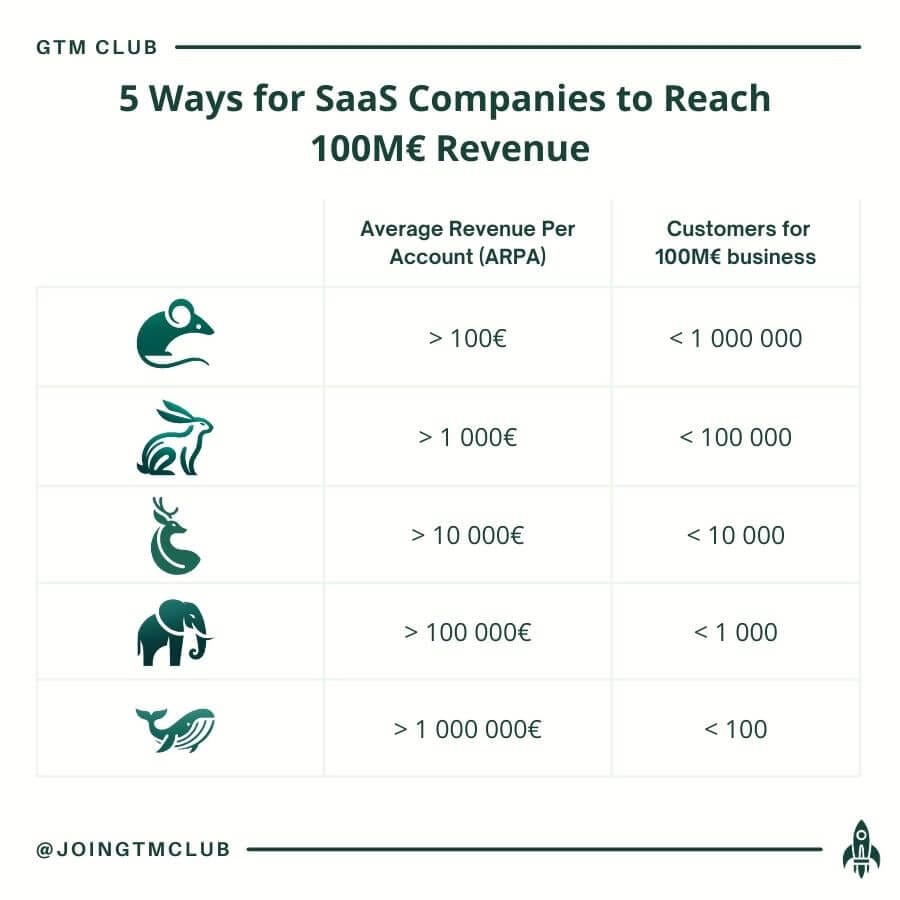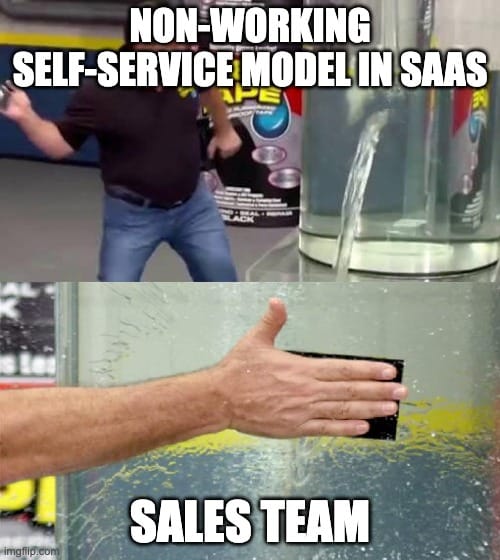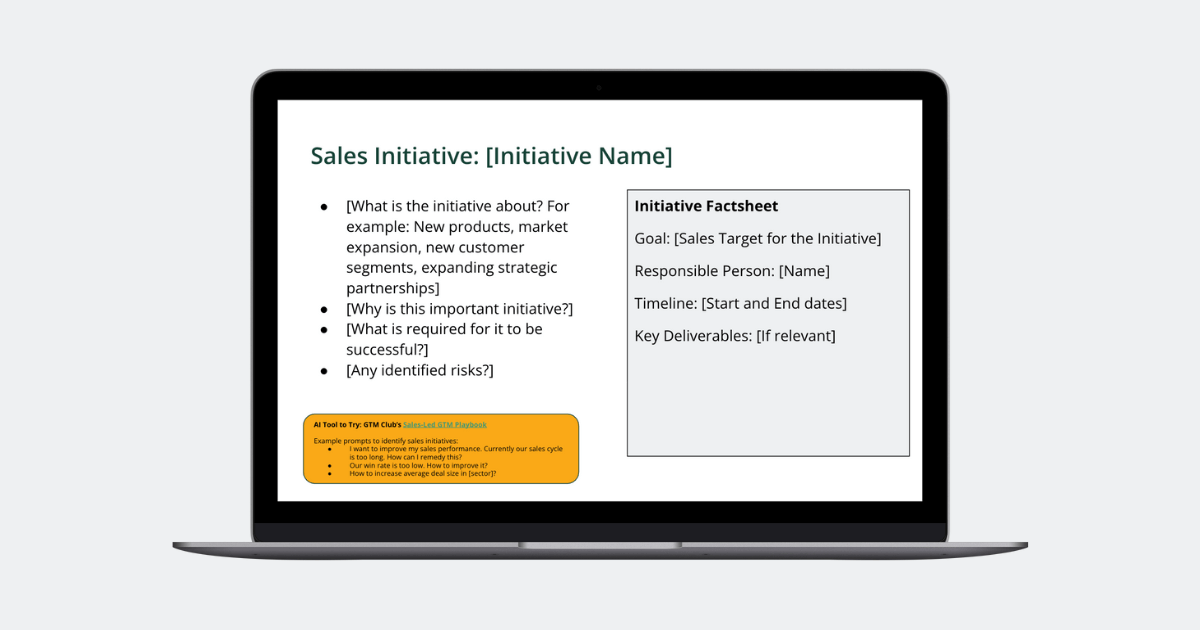GTM Club's Guide to Sales-Led GTM
A sales-led go-to-market strategy drives growth when selling complex and high-value products in the B2B tech sector. GTM Club's guide will help you understand sales-led GTM.

Choosing the right go-to-market strategy is crucial for success in the competitive B2B technology market. Sales-led GTM has become a go-to approach for companies selling complex or high-value solutions to SMEs and bigger enterprises. This article will help you understand sales-led GTM, who it's for, and how to implement it successfully.
More specifically, here we cover:
- Why is sales-led GTM important?
- What is go-to-market?
- What is sales-led GTM?
- What are the key characteristics of sales-led GTM?
- What are the prerequisites for sales-led GTM?
- What is the difference between sales-led GTM and product-led growth?
- What are the benefits of sales-led GTM?
- What to know before committing to sales-led GTM?
- How do you succeed with sales-led GTM?
- How to get started with sales-led GTM?
Why Is Sales-Led GTM Important?
“Next year, we need at least double our revenue!”
Every startup CEO states a sentence similar to this. Some are notably more aggressive, aiming to rocket their AI-native startups millions of ARR in mere months. CEOs in established companies, then, might have more conservative growth targets. The common goal for all of them is to accelerate sales. A systematic effort is required for a company with ambitious growth goals; just winging it is not an option.
Reaching set targets is a company-wide imperative.
Meeting growth targets is always vital on both personal and company levels. If a start-up falls behind its growth targets, it will lose interest from investors, and access to ever-important capital becomes more difficult. On the other hand, stock-listed companies see the impact of failing to deliver on the company's market value. On a more personal level, regardless of company size, missing targets leads to top management's position becoming shaky at best and sales reps are left without commissions. Reaching set targets is a company-wide imperative.
What is GTM?
GTM comes from the words go-to-market. A go-to-market strategy or motion refers to the combined action of selling products or services to customers. It outlines various strategies, tactics and activities to engage your target audience (via both marketing and sales), drive conversions, and win and grow customer accounts.
GTM is not just a new product launch or market expansion.
Go-to-market is not just sales or marketing. It's a cross-functional effort, led by the CEO, involving teams from marketing, sales, product management, customer support, and occasionally finance and operations, to ensure a comprehensive strategy and execution. It's also not just a new product launch or market expansion. It’s crucial whenever you're looking at how to reach and serve customers.
GTM is crucial when considering how to reach and serve customers.
Presumably, your task is to grow the business as fast as possible. Defining your GTM strategy finds you the fastest way to grow your business while minimising friction. GTM strategy answers at least the following questions:
- What are you selling (unique value proposition)?
- Who are you selling to (ideal customer profile and why them)?
- How do you reach and engage your potential customers (messaging, channels for marketing and sales)?
- How do you win, keep, and grow your customers and market share (sales plans and playbooks, service delivery, customer support, etc)?
- How do you measure success (KPIs, profitability, revenue growth, etc)?
See Matthew Lush's LinkedIn post for his take on what GTM is and is not.
What is Sales-Led GTM?
Sales-led GTM is a go-to-market motion commonly adopted by those in the B2B tech sector, typically offering complex and high-value items. Their business can involve a consultative sales process that focuses on developing relationships, understanding customers' needs, and providing customised solutions, but it's not uncommon to simply "push products" either. Sales-led GTM is also known as sales-led growth (SLG).
Sales-led GTM is also known as sales-led growth.
A sales-led go-to-market strategy emphasises sales efforts to facilitate customer acquisition and business growth. It positions the sales function as the company's primary driver of growth and revenue. A key idea in sales-led GTM is to empower sales teams to pursue and win opportunities with both new and existing customers.
GTM motion answers where and how you can grow the fastest with the least friction. Those operators who have chosen to accelerate growth with a sales-led approach have found that a professional sales team is the quickest way to acquire new ideal customers and grow revenue while minimising friction, such as costs and wasted time.
| Hierarchy | Examples / Options | Core Idea / Key Questions |
|---|---|---|
| GTM Motion | Product-led Sales-led Partner-led |
1) Who/what drives growth? 2) How are customers engaged? |
| Sales-led GTM | Inbound sales Outbound sales |
1) Sales reps guide the customer journey. 2) Customers meet sales before they try the product. |
| Inbound Sales | SEO Events & webinars Online Ads Etc… |
Sales responds to demand created by marketing. |
| Outbound Sales | Cold calls Cold email LinkedIn outreach Etc… |
Sales proactively reaches out to prospects. |
Based on the questions in the previous segment, a sales-led GTM could look like this on a high level:
- What are you selling?
- Product: AI-powered marketing automation platform for banks.
- Unique Value Proposition: Only AI-powered marketing automation platform integrated with Microsoft Dynamics CRM. AI features enable a team of five marketers to do the work of 15.
- Who are you selling to?
- Ideal Customer Profile: Banks that are challenging for the local market leader position and have invested in Microsoft Dynamics CRM.
- Why: Your product can match their desire for growth, and they have a notable marketing budget to invest in empowering growth, but are held back by marketing headcount.
- How do you reach and engage your potential customers (messaging, channels for marketing and sales)?
- Messaging: "Outpace your competition by turning your marketing team into a marketing powerhouse. Leverage customer data from Microsoft Dynamics with AI."
- Channels: Local enterprise sales teams supported by account-based marketing, heavily leaning into LinkedIn and email, and by attending trade shows and industry events.
- How do you win, keep, and grow your customers and market share (sales plans and playbooks, service delivery, customer support, etc)?
- Customer acquisition: Full-cycle account executives supported by account-based marketing and three times per year campaigns with outsourced SDRs.
- Upsell by the account executive while the customer success manager supports on a day-to-day basis. Service delivery is done by the onboarding team in collaboration with the customer success team.
- How do you measure success (KPIs, profitability, revenue growth, etc)?
- Sales KPIs: Sales velocity, sales margin & net revenue retention
- Revenue growth +20% and profitable
Key Characteristics of Sales-Led GTM
Sales-led GTM is characterised by its high-touch sales process, where sales representatives connect with prospects before they have a chance to go hands-on with the product. This approach is most efficient for complex solutions that require significant customer education and support. The strategy typically targets larger companies with comprehensive needs and longer decision-making processes.
For example, some well-known global companies that are nailing sales-led GTM are ServiceNow and Salesforce.
Sales-Led Success Is Built on a Long-Term
Committing to sales-led growth is one of the most substantial and expensive decisions a company can make. Too often, companies bring on sales reps without a solid strategy, expecting revenue to materialise. However, a professional sales team isn't just expensive in terms of salaries; building a successful team demands significant time, focus, and resources.
Sales-led growth is about building a system where sales consistently succeed and deliver value.
Sales-led growth is about building a system where sales consistently succeed and deliver value to both colleagues and other functions, and most importantly, in the service of customers. Each successful sales interaction fosters trust, enhances market positioning, and sets a higher standard for future interactions, thereby multiplying its overall impact.
Sales-led GTM can become a significant competitive advantage.
Sales-led success is not achieved overnight. Given time and adhering to a systematic approach, it can become a significant competitive advantage.
Who Should Adopt Sales-Led GTM?
Not every company can grow with sales-led GTM. Certain noteworthy prerequisites are required to make it suitable as a GTM motion. Success with a sales-led approach depends on three essential criteria that must be carefully evaluated:
- Having a sales team must make sense economically.
- The prospect can't successfully buy the product and onboard themselves.
- Sales reps must add value both internally and externally.
Before diving into those three requirements, let’s align on some terminology. Sales resources, methodology, and go-to-market strategy must align with the company's products and services to scale the business. This is no easy feat for any company, regardless of its size. To help, Christoph Janz at Point Nine Capital created a well-known categorisation of deal sizes in tech, most suitable for SaaS companies.
To succeed, companies must align their GTM strategy with the size of accounts they can win and grow with.
As you can see in the graph below, a mouse presents a deal with very little money each year, while a whale represents a whale-sized pile of annual income. Growing a company to 100M€ of annual recurring revenue (ARR) requires many more mouse-sized customers than whale-sized customers. To succeed, companies must align their GTM strategy with the size of accounts they can win and grow with.

Moving upwards to bigger targets increases the likelihood of success with sales-led growth. There are exceptions to every rule, and while unlikely, it is possible in sales-led GTM to successfully target smaller animals too, especially if heavily aided by AI and automation.
For reasons explained below, it is recommended to start utilising the B2B sales function when revenue per account approaches a few thousand annually (sorry, Bambi) and even then, with a light touch. Ideally, marketing heavily supports deer hunting, but a fully grown deer also justifies investing in a proactive extended SDR team and outbound sales motion. Bigger targets then move heavily on enterprise sales turf with dedicated teams. These guidelines are becoming hazier as AI development raises the self-service threshold.
Economical Criteria to Win with Sales-Led Growth
Having a sales team costs a lot of money. Good salespeople know their value. In addition to direct salary costs (and sales commissions), they need a whole system to support them from a management, training and sales enablement point of view.
Good salespeople know their value.
It is always a bit business-dependent, but having a sales team hunting mice generally makes no financial sense, as marketing should attract them to the cheese (your product). Having the emphasis on the sales team starts to make sense from deer and above, as already mentioned. The average deal size and resulting margins must be high enough to justify multiple discussions with prospects before they make a purchase. One must also remember that for most companies, their opportunity win rate is well below 50%, so the time spent on not-won opportunities is a significant cost.
An important aspect to note here is that we are not discussing how sales are initiated: Sales-led GTM works for both inbound and outbound sales. The key difference here is to strongly emphasise the sales team leading the sales process with the prospects. Then, on a more tactical level, the company can discuss whether investing more in inbound makes sense over having a proactive SDR team leading outbound efforts.
For example, we at GTM Club use Canva for graphics. The money we pay for the licence is a tiny mouse. Having someone convince us to use the tool in the first place would not be profitable, with less than 150€ annually coming in after winning an opportunity with us. As Canva's results have shown, it is much better to let us explore the platform and start paying for additional features at our own.
Product Criteria to Meet for Sales-Led Growth
Now think of the opposite of Canva. A product that is complex and requires customisation or an implementation project. We can use CRM as an example, as Salesforce is one of the companies that famously utilises sales-led GTM.
Nowadays, Salesforce CRM can be tried for free. Still, a large organisation must go through a complex sales process to buy and implement it, which is often taken over by an implementation team from one of Salesforce's partners. This does not sound like a solution that the customer would independently buy online and start using successfully. No wonder Salesforce has active local sales teams working in the global markets to build a pipeline with elephants and whales.
If you want additional examples of complex sales, look at what is happening in cybersecurity. We see elephants!
It probably goes without saying that the product must also generate sufficient benefits for customers to justify purchasing at a high enough price point. The benefits are then demonstrated to prospects in various ways depending on the GTM motion.
Products with features that create a wow effect during demo sessions directly accelerate sales.
User experience is essential for both sales-led and product-led growth, but it should be emphasised when prospects study the product independently. Then, they need to experience the value immediately and understand, without guidance, how to use various features. On the other hand, with a skilled sales professional, features that create a wow effect are worth their weight in gold during sales demos. There is a middle ground: free trials, where a hands-on test follows a successful sales demo. Free trials turn into sales only when correctly set up by the sales team.
Value-add From Sales to Accelerate Sales-Led Growth
A sales team, big or small, needs to add value to justify its existence. And it must do so meaningfully for the prospects' experience and the company itself.
Too many companies have "fixed" their failing self-service models by hiring a sales team. Paradoxically, the reason for this is sometimes avoidance of costs, as hiring a sales team of one or two representatives can be seen as a cheaper option than fixing the online funnel. In the long run, however, it is rarely the case. Adding a sales team to a sales process that does not require them tends to slow down the sales cycle.

In most cases, the value added from sales is clear: The sold product is complex, and as explained in the previous section, prospects need support in understanding how to use it best to solve their problem.
Buying does not happen without sales helping customers to make educated decisions.
Part of the sales role is to help customers make educated decisions. How they do it, then again, is a product- and company-specific decision. For example, sales provide value in a significantly different way during the sales process for the same product when it is sold as inbound and outbound. Using the cybersecurity and backup solution as an example (see the complete example on how to align deliverables with an extended SDR team).
The prospect already knows or suspects that investments in cybersecurity are needed. The additional value the sales executive focuses on is the specific concerns and requirements that the prospect has already identified.
Outbound:
Educate the prospect on the latest developments in cybersecurity, and through discovery, a sales executive helps them evaluate whether their security is up to date or additional investment is needed.
Enabling buying is an effective way for a sales team to add value, even when the product is otherwise accessible, easy to understand, and easy to implement. Decision-making requires multiple stakeholders and can be a complex process, so having a professional sales representative to help navigate opportunities to a decision and then carry the contract through the red-line phase is beneficial to both parties. This seemed to be part of Zoom's growth strategy during the pandemic.
GTM Motions Are a Scale
Sales-led route is most definitely not the only game in town. There are full alternatives, hybrid models, and a bit of definition and jargon fighting going on.
Sales-Led GTM vs Product-Led Growth
Product-led Go-To-Market, commonly referred to as Product-led Growth (PLG), focuses on the product driving customer acquisition, business growth, and retention. This strategy leverages the product's value and usability to naturally attract, engage, and retain users, bypassing traditional sales tactics. With PLG, an intuitive user experience and the product's inherent features encourage users to transition from free or basic versions to advanced, paid options.
The alternative to a sales-led approach is product-led growth, or PLG.
On a practical level, sales-led GTM is a sales approach where the sales team interacts with customers before they get hands-on with the product. Meanwhile, in PLG, the purchase can be made entirely without interacting with anyone at the company. The product "sells itself" and buying often happens independently with a credit card.
Drilling even more into the nitty-gritty, if a tech company's website says “Contact Sales” or “Book a demo,” you can be pretty sure you are looking at a sales-driven company.
Marketing-Led GTM is Sales-Led GTM
Marketing-led go-to-market is a term that has not been defined as well as sales-led and product-led growth have been. Most commonly, marketing-led GTM or marketing-led growth refers to sales-led GTM with a strong emphasis on inbound marketing to generate inbound leads.
Hybrid GTM Motions
It's not product-led growth vs sales-led GTM. With good execution and planning, both can co-exist in the same thriving company.
Many successful companies combine elements of both product-led and sales-led GTM to maximise market coverage. In this hybrid approach, companies offer self-service options for smaller customers while maintaining dedicated enterprise sales teams for larger accounts. Canva and Salesforce are examples in the sections above. Canva has hired an enterprise sales team, and Salesforce is expanding its offerings to smaller companies with a self-service approach.
Many successful companies combine elements of both product-led and sales-led GTM to maximise market coverage.
As an additional example, when ChatGPT took off, OpenAI quickly established an enterprise sales team. Now, ChatGPT is available for purchase through a simple online process for smaller teams. Simultaneously, they operate a dedicated enterprise sales team that serves larger organisations with enterprise-grade requirements and, of course, higher contract values.
When executed well, this hybrid model creates a powerful synergy: the product experience that drives PLG success also accelerates enterprise sales. Enterprise prospects can experience the product firsthand before engaging with sales, making the subsequent sales process more efficient and effective. Sales teams benefit from prospects who already understand the product's value, allowing them to focus on addressing enterprise-specific requirements, integration needs, and organisational adoption strategies.
Pros and Cons of Sales-Led GTM
Sales-led GTM indeed has certain notable drawbacks, including higher personnel costs. However, for companies suitable for sales-led growth, the benefits outweigh the disadvantages.
Benefits of Sales-Led GTM
Companies that adopt this strategy can benefit significantly from the five key advantages of sales-led GTM.
- High Average Deal Size
Sales-led companies can effectively target larger businesses and enterprises that require comprehensive support and guidance during their decision-making process. In a sales-led model, it is possible to close smaller deals; however, these deals should typically be larger than those that customers purchase independently. - Enhanced Customer Engagement and Relationships
Sales-led strategies enable direct interactions with customers, facilitating a deep understanding of their needs and allowing companies to tailor offerings accordingly. This leads to strong customer relationships, improved customer experience, and even increased customer lifetime value. - Control Over the Sales Process
The sales-led approach enables companies to quickly refine their sales tactics and strategies in response to customer feedback, product updates, and market changes, similar to those in the founder-led sales model. Sales-led models provide transparent metrics for evaluating performance, such as the volume of sales activities, sales cycle, and customer acquisition costs, making it possible to forecast future sales. - Targeted Sales Activities
This one is undoubtedly related to the above but significant enough to mention on its own. With a sales-led approach, the sales team selects which potential customers to focus on, allocating time and effort accordingly. Concentrating on prospects that match the company's offering should lead to elevated win rates and, in the long term, high customer retention. The sales team builds a well-informed customer base through sales demos and sales collateral. - Personalised Onboarding and Customer Support
Unlike product-led growth companies, where customers may self-navigate through onboarding, sales-led companies often assign a dedicated representative to guide new customers. The approach with personal support helps new users understand the product better, addresses any immediate questions, and personalises the onboarding experience, leading to a more satisfying customer experience and customer loyalty.
The sales-led approach enables companies to quickly refine their sales tactics and strategies in response to customer feedback, product updates, and market shifts.
Hindrances of Sales-Led GTM
It's important to understand the potential challenges with sales-led growth before committing to it.
- Higher Costs
With sales-led growth, a large amount of capital is invested in the growth driver: the sales team. To drive growth, the sales team requires significant investment, including salaries, sales commissions, training, support, and enablement, all of which contribute to higher customer acquisition costs. - Longer Sales Cycles
Unlike in product-led growth, the offering in sales-led GTM is not as self-explanatory and won't sell itself. The amount of money the customer is asked to part with is usually high, so multiple rounds of discussions and decision-making will be required. A sales dialogue that starts this week can easily take weeks or sometimes years, impacting cash flow and revenue growth. - Scalability Challenges
Sales-led growth can encounter scalability issues as the business expands and grows. This model relies heavily on sales personnel's abilities to close deals, so the comings and goings of individual account executives can have a noticeable impact on business results. In addition, to grow, the company needs to have access to new, skilled sales professionals and a system to nurture talent in-house.
Key Components of Successful Sales-Led GTM
Success in sales-led GTM heavily depends on comprehensive sales team enablement. This includes investing in thorough product training, developing effective sales materials, implementing robust CRM systems, and maintaining regular coaching programs to ensure continuous team development. While products can be widely different, some components are shared by successful organisations executing the sales-led GTM playbook.
Sales Plan Is a Must
A comprehensive sales plan serves as the foundation for sales-led GTM execution. Completing an annual sales planning cycle requires time and effort. A comprehensive sales plan consists of three key sections: analysing the market landscape and setting clear objectives; detailing sales team structure, performance metrics, and sales-marketing alignment; and addressing budget allocation, risk management strategies, and execution timelines with quarterly goals.
Selling Successfully Requires You to Know Your Prospects
Knowing your customers is paramount in sales-led GTM, as it enables sales teams to prioritise leads and opportunities for work and tailor their approach and offerings to meet specific needs. Learning to know prospects and customers occurs through the ever-important process of qualification and discovery. Utilising qualification frameworks such as CHAMP, BANT, and enterprise deal-ready MEDDIC helps sales teams identify the most promising targets.
Sales Demos Accelerate Sales
Building on learning about prospects and customers through qualification and discovery, sales demonstrations play a crucial role in sales-led GTM. They are powerful tools for showcasing the value of the sold product and building rapport and relationships with prospects. It is notable how these success factors relate to each other, as through discovery, sales teams learn prospects' needs, pains and goals to personalise and customise sales demos. A well-executed sales demo is a textbook example of how to work according to sales-led GTM!
A well-executed sales demo is a textbook example of how to work according to sales-led GTM!
Effective Sales Pipeline Management Is a Must
Pipeline management is essential in sales-led GTM, as the sales team is the primary driver of revenue growth. For sales leadership, reviewing the sales pipeline is one of the most powerful tools to support and enable their sales teams. Reviewing the sales pipeline regularly helps maintain a healthy pipeline, identify bottlenecks, and ensure deals progress smoothly through each stage.
Monitoring Technologies and Trends
Monitoring how technology and AI reshape the playing field is a critical responsibility for sales leaders. As highlighted in our 2025 success factors, AI is fundamentally changing the game. Sales leaders must stay informed about emerging AI capabilities across the entire sales cycle. For example, AI tools are transforming discovery by automating research, providing real-time coaching, and capturing insights in an automated manner. Now, operators must understand how to implement AI to empower their teams while maintaining human judgment, creativity, and relationship-building skills.
Operators must understand how to implement AI to empower their teams.
Getting Started with Sales-Led GTM
To start your journey towards a sales-led go-to-market, you must invest in a professional sales team (if you are transitioning from founder-led sales) or, in the case of more established organisations, enable the sales team to drive the company's growth.
Are you considering implementing a sales-led GTM strategy? Here are your next steps:
- Evaluate your readiness and fit for using our Sales-Led GTM Checklist.
- Commit to sales-led growth. Don't just tip your toe.
- Use our Annual Sales Planning Template to craft a winning GTM plan. You don't need to wait until next year; you can join in immediately!
Unlock Sales-Led Growth, Subscribe to the GTM Club Newsletter
Sales-led GTM can be a powerful strategy for B2B companies selling complex, high-value solutions. Successful implementation of sales-led GTM requires careful planning, adequate resources, and ongoing optimisation of your sales processes. The benefits of transitioning to a sales-led company might not be apparent overnight. However, you should eventually start seeing more traction on sales KPIs, and the company should find a shared tone and direction.
Note: This article was originally published on March 31, 2024, and has since been edited for clarity, and to reflect the development of sales-led growth since then and availability of new articles.




